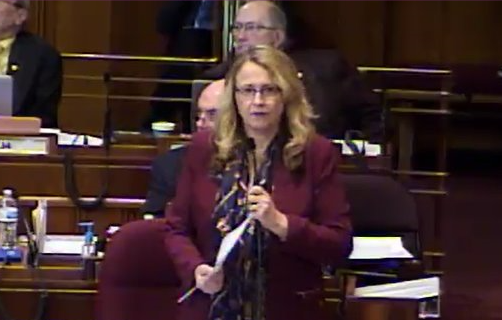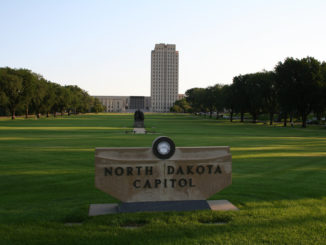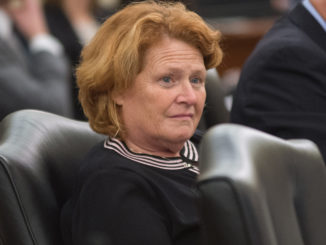
I’ve noticed some segments of social media that are ablaze with the idea that dismemberment abortion is now banned in North Dakota. It’s an idea certainly worthy of celebration. After all, what kind of person thinks it’s okay to use the barbaric method of tearing a baby limb from limb as a means of terminating its life? The only problem is, that North Dakota’s dismemberment abortion ban doesn’t really ban them at all— at least not for now.
We were the first to report that a dismemberment abortion ban was in the works way back in mid-December. It passed the House on January 31st by a vote of 78-13. And yes, it’s true that House Bill 1546 passed the Senate last Friday on a vote of 39-7. There’s no denying that.
In case you’re unfamiliar with this abortion procedure — also known as “dilation and evacuation” — there’s little doubt that this description will clear it up for you:
“‘DISMEMBERMENT ABORTION’ means, with the purpose of causing the death of an unborn child, purposely to dismember a living unborn child and extract him or her one piece at a time from the uterus through use of clamps, grasping forceps, tongs, scissors or similar instruments that, through the convergence of two rigid levers, slice, crush, and /or grasp a portion of the unborn child’s body to cut or rip it off. This definition does not include an abortion which uses suction to dismember the body of the developing unborn child by sucking fetal parts into a collection container.”
Now you see why I refer to it as “barbaric”. Unfortunately, the Senate version of the ban on this procedure ended up including a trigger amendment that the original version didn’t have. But the idea of a trigger didn’t originate in the Senate. The version that passed the House had one too.
After passing the House, questions arose over the trigger language that had been added to the bill. That language was as follows:
“Section 1 of this Act becomes effective on the date the legislative management approves, by motion, the recommendation of the attorney general to the legislative management that it is reasonably probable this Act would be upheld as constitutional.”
This language was viewed as ambiguous by the Attorney General’s Office. So, the Senate Judiciary Committee worked with them and Legislative Council to craft the following language:
“This Act becomes effective on the thirtieth day after:
“1. The adoption of an amendment to the United States Constitution which, in whole or in part, restores to the states the authority to prohibit abortion; or
“2. The attorney general certifies to the legislative council the issuance of the judgment in any decision of the United States Supreme Court which, in whole or in part, restores to the states authority to prohibit abortion.”
As I said in the beginning of this article — and as I’ve proven to you here as well — in its current form, this bill does absolutely nothing to prohibit dismemberment abortions from being done in North Dakota today. I promised you in my January 31st article that I would cover some interesting twists and turns with this bill at a later time. Well, I’d like to touch upon that now.
When the former Executive Director of North Dakota Right to Life, Paul Maloney, decided that it was time to put this bill forward, he expected to find eager support for the idea from his connections in the pro-life community. Unfortunately for Maloney, that wasn’t the case.
Aside from having the language of the bill drafted, Maloney needed legislators to sponsor it. The first person he had turned to in the legislature on this bill was Senator Janne Myrdal (R – District 10)— who is also chair of the Pro-Life Caucus. She asked Maloney to wait until the first pro-life caucus meeting before looking for any sponsors. Ultimately, Rep. Luke Simons (R – District 36) unapologetically stepped forward and agreed to be the prime sponsor of the bill.
As a side note, there were 12 spots available on this legislation for bill sponsors— six for the House and six for the Senate. You’ll notice that one spot is vacant on the Senate side, and Myrdal’s name is nowhere to be found. Why?
The fact that Paul Maloney received less than enthusiastic support from some in the pro-life community — who he thought that he could depend upon — coupled with the fact that trigger language was added to the bill, is a sad back story to legislation that does nothing in the immediate to prevent dismemberment abortions from occurring in North Dakota.
The fact that the current bill does nothing was actually pointed out by a Democrat during floor debate last Friday. Senator Erin Oban (D – District 35) stood and, in part, said this:
“I’m going to vote for it, because it doesn’t do anything. All this does is check another box for the legislature to say how pro-life they are.”
And she did. Oban hit the green button and in doing so seemed to make a mockery of the pro-life community.
One of the arguments against the ban was that these abortions don’t occur in North Dakota. But we’re left to wonder if that’s entirely true when we consider this statement in a recent article from Forum News Service’s John Hageman:
“Elizabeth Nash, a state policy analyst for the Guttmacher Institute, a reproductive rights group, previously said such method bans effectively prevent abortion at about 15 weeks of pregnancy because it’s the only procedure available for most abortions after that time. Roughly 3 percent of the 1,155 abortions performed in North Dakota in 2017 took place at 15 weeks of pregnancy or more, according to the latest state Department of Health data.
“The department said 2015 marked the last year on record in which a dilation and evacuation procedure was performed in the state.”
It seems we have conflicting information here. On the one hand, we have the Guttmacher Institute saying 3% of abortions in North Dakota during 2017 took place at a time dismemberment is done. On the other, the Department of Health is claiming 2015 was the last time a dismemberment abortion took place. Which is it? And when will we have information about 2018?
The sad thing is that in a sense it doesn’t make much of a difference, because the powers that be took the bill of an unapologetic pro-life legislator named Luke Simons from standing for something and turned into a version of something that does nothing.
Update: The House concurred with the changes in the Senate and the bill has been sent to the governor.
PLEASE LIKE & SHARE!
Sources:
- https://theminutemanblog.com/2018/12/15/bill-in-the-works-to-ban-dismemberment-abortions-in-north-dakota/
- https://theminutemanblog.com/2019/01/31/dismemberment-abortion-ban-passes-north-dakota-house/
- https://www.legis.nd.gov/assembly/66-2019/bill-index/bi1546.html
- https://www.nrlc.org/uploads/stateleg/DismembermentFAQJan15.pdf
- https://www.legis.nd.gov/assembly/66-2019/documents/19-1039-04000.pdf
- https://www.legis.nd.gov/assembly/66-2019/documents/19-1039-01000.pdf
- https://www.willistonherald.com/news/health/north-dakota-state-senate-approves-abortion-method-ban/article_45802910-5269-11e9-917f-733b579dec6d.html?fbclid=IwAR3qRYuu3JeGM0DvvJnqkTOPORm3NzhTF6xzSEyvQIMJ6erEcMq3PUd0J2k





